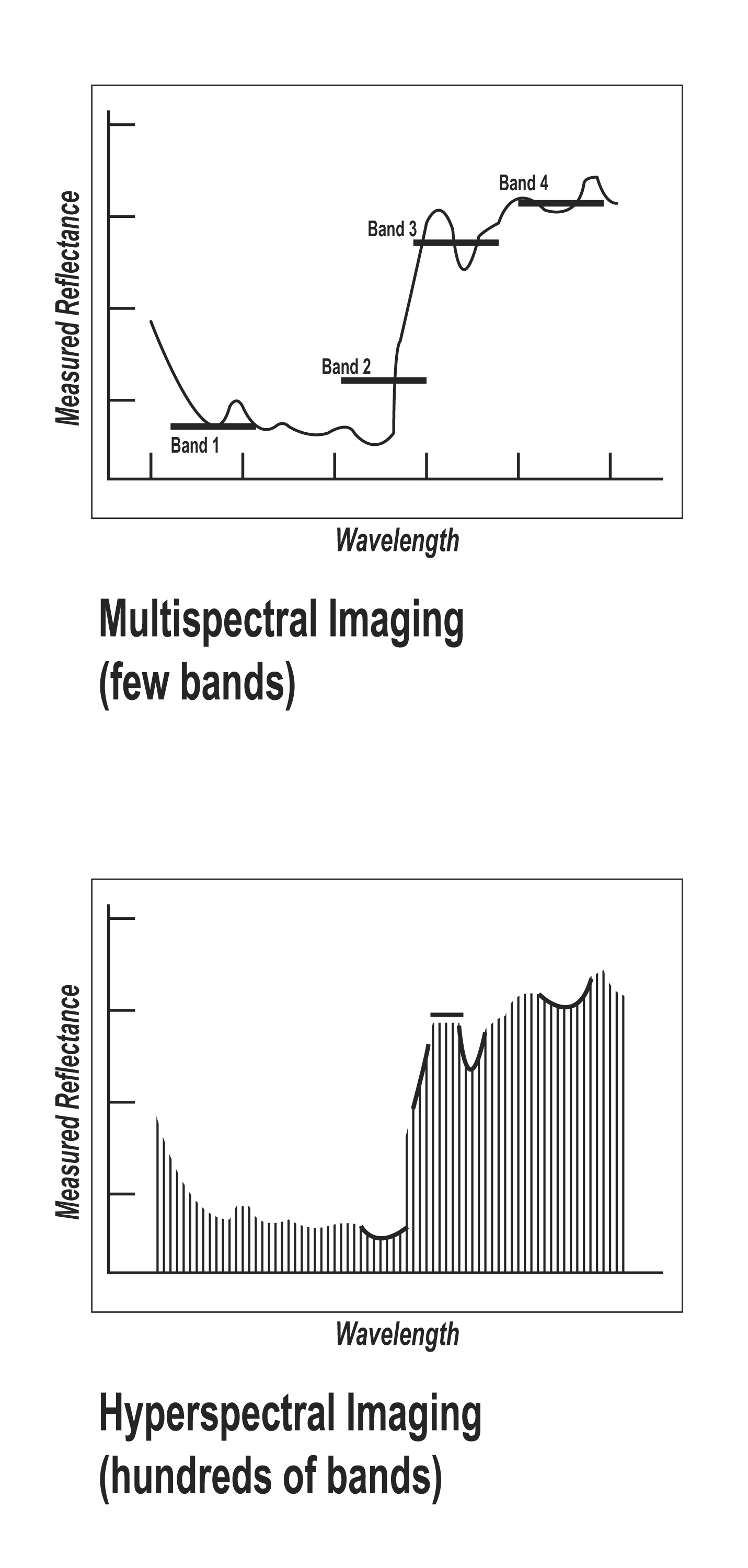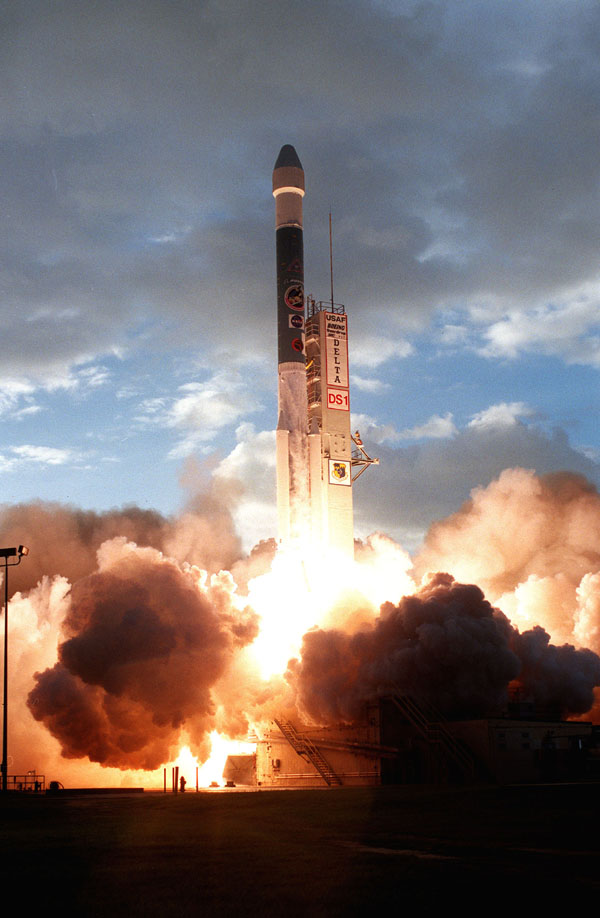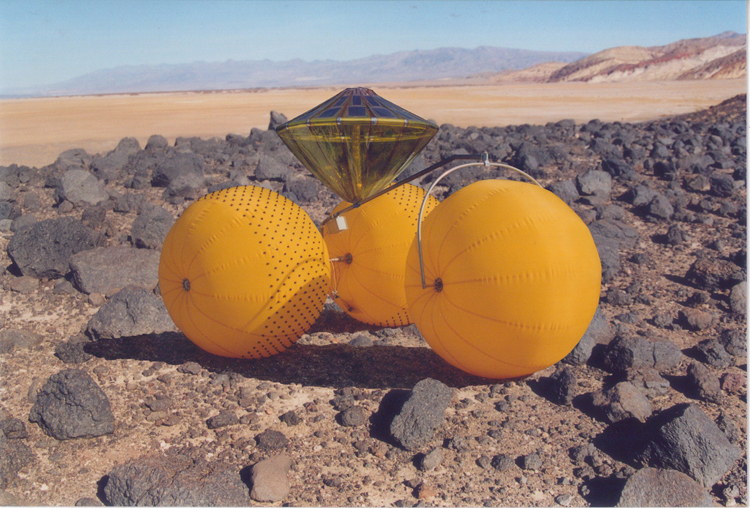Next Launch
Total Students
2,609
Total Launches
683
Eggs Survived
418 61.2%
Rockets Survived
536 78.5%
March 1, 2003
Musical Satellites
by Dr. Tony Phillips
If light were sound, then
chemicals would play chords. Water: C major. Cyanide: A minor.
Chlorophyll: G diminished 7th. (Please note that the choice of chords here is only for
the sake of illustration, and not meant to reflect the actual spectra
of these chemicals.)
It's a loose metaphor, but an apt one. Musical chords are
combinations of frequencies of sound (notes), while chemicals leave unique
combinations of dips in the frequency spectrum of reflected light, like
keys pressed on a piano. Spectrographs, machines that recognize
chemicals from their "chords of light," are among the most powerful
tools of modern chemistry.
Most earth-watching satellites, like the highly successful Landsat series,
carry spectrographs onboard. These sensors measure the spectra of light
reflected from forests, crops, cities, and lakes, yielding valuable
information about our natural environment. Current satellites do this
in a fairly limited way; their sensors can "hear" only a few meager
notes amid the symphony of information emanating from the planet below.
EO-1 could change that. Short for "Earth Observing 1," EO-1 is an experimental NASA
satellite in orbit since 2000. It's testing out a more
advanced "spectrometer in the sky"-the Hyperion hyperspectral
imager. How good is it? If Landsat were "chopsticks," EO-1
would be Gershwin's "Rhapsody in Blue."
The Hyperion sensor looks at 220 frequencies in the spectrum of visible
and infrared light (0.4 to 2.5 microns) reflecting off Earth's surface.
Landsat, in contrast, measures only 10. Bryant Cramer, who
manages the EO-1 project at the Goddard Space Flight Center, puts these
numbers in perspective. "If we flew Landsat over the northeastern
United States, it could readily identify a hardwood forest. But using
hyperspectral techniques, you probably can . . . tell the oak trees
from the maple trees."
Future earth-watching satellites may use Hyperion-like instruments to
vastly improve the environmental data they provide. EO-1 is paving the
way for these future missions by taking on the risk of flight-testing
the sensor for the first time. For farmers, foresters, and many others,
this new remote sensing technology will surely be music to the ears.
Read about EO1 at http://eo1.gsfc.nasa.gov.
Budding young astronomers can learn more at
http://spaceplace.nasa.gov/eo1_1.htm.
This article was provided by the Jet Propulsion Laboratory, California Institute of Technology, under a contract with the National Aeronautics and Space Administration.
 The Hyperion instrument distinguishes hundresd of wavelength bands, while current Landsat instrumens image only a few.
The Hyperion instrument distinguishes hundresd of wavelength bands, while current Landsat instrumens image only a few.
April 1, 2003
Eggs in the Air
by Patrick L. Barry
The sky will be filled with flying eggs on May 10, 2003, when a thousand students converge on The Plains, Virginia, for the first-ever national high school rocketry competition.
Called the Team America Rocketry Challenge (https://rocketcontest.org), the competition sets the goal of flying a custom-built, two-stage rocket carrying two raw eggs to a height of exactly 1,500 feet, and then returning the eggs to the ground unbroken. The team that comes closest to 1,500 feet without breaking their eggs will win the national title.
The competition is being organized by the Aerospace Industries Association and the National Association of Rocketry (NAR). NASA administrator Sean O'Keefe will attend the final event.
"The idea is to get kids interested in the world of aerospace," says Trip Barber, director of the competition and vice-president of the NAR. "And they will learn some important lessons about the power of math and science-and cooperation and teamwork-along the way."
To develop their designs, the students first used computer simulator software provided by NAR. Then they had to apply old-fashioned ingenuity and craftsmanship to bring the design to life and flight testing to refine it.
Students constructed rocket bodies using a combination of hobby-store rocket kit parts and custom materials. A typical rocket might consist of cardboard tubes from paper-towel or wrapping-paper rolls, a pre-made nose cone, rocket-kit body segments cut to size, and light-weight, balsa wood fins. But the greatest challenge for many was designing the compartment for the eggs.
Some used plastic Easter eggs as casings, padding the inside with bubble wrap, foam peanuts, or even gelatin. Others decided not to "reinvent the wheel," making a cradle from the egg-crate material used for shipping eggs. Some chose to make larger, more powerful rockets big enough to carry the eggs inside, while others made smaller, more efficient rockets that have a bulging egg compartment mounted on top.
A hundred unique designs will be put to the test in Virginia. Only one will win. But for the students, the real prize has already been won: Learning an approach to problem-solving that works, whether you're launching eggs over a field or sending astronauts to Mars.
In the end, it's all about the future: Future technologies and the kids who will grow up to create them. Many advanced technologies are being developed now by NASA's New Millenium Program (https://www.jpl.nasa.gov/nmp/). Who will do that work in the future? Perhaps some kids who spent their weekends launching eggs in the air.
Are you a kid? Would you like to build your own rocket? Visit NASA's Space Place and learn how to make a bubble-powered rocket! (https://spaceplace.nasa.gov/pop-rocket/en/). It won't take you to Mars, but it's a good way to get started. NASA also has a handbook of rocketry for students and educators.
This article was provided by the Jet Propulsion Laboratory, California Institute of Technology, under a contract with the National Aeronautics and Space Administration.
 A Boeing Delta II (7326) rocket launched the New Millennium Program Deep Space 1 spacecraft on October 24, 1998.
A Boeing Delta II (7326) rocket launched the New Millennium Program Deep Space 1 spacecraft on October 24, 1998.
June 1, 2003
Monster Trucks on Mars
by Patrick L. Barry and Dr. Tony Phillips
We all know what Mars rovers look like now:
Robotic platforms, bristling with scientific instruments, trundling along on
small metallic wheels. Planetary rovers of the future, however, might look a
little different-like miniature monster trucks!
Enormous, inflatable
tires can easily roll right over the rocks and rugged terrain of alien planets,
just as they bound over old cars like as many speed bumps.
That's the
idea behind a novel concept for robotic planetary rovers known as the "big
wheels inflatable rover." Unlike rovers similar to the Sojourner robot that
explored the surface of Mars in 1997 that depend on instructions sent from Earth
or complex programmed intelligence to steer through rough terrain, this rover
has three beach ball-like tires roughly five feet across that make it a true
off-road vehicle.
"We sent this rover out to Death Valley, to a place
called Mars Hill that has a general geological formation like Mars, and nothing
could stop it," says Jack Jones, the mastermind of the inflatable rover concept
at JPL. "It just kept going and going and going."
Lots of current
research is devoted to developing advanced robotic intelligence that allows
rovers to detect rocks in their path and maneuver around them. The alternative
to such on-the-spot intelligence is tedium: Ground controllers on Earth working
out the maneuvers by hand and waiting an hour or more for the instructions to
travel to the distant planet.
A "big wheels" rover would need such
computer intelligence to avoid very large boulders, but Jones asks, "Why worry
about every little rock, pebble, and crack when you can just roll right over
most of them?"
Jones imagines a scenario where multiple inflatable-wheel
rovers could be sent out to explore the Martian terrain-easily and quickly
traversing the rugged terrain. Samples gathered by the rovers could be returned
to a central, stationary laboratory module for detailed analysis.
"The
Martian surface is really very, very rough with a lot of rocks, and to be
banging this laboratory equipment up and down over all of these rocks aboard the
rovers doesn't make much sense," Jones says. "I suspect it might be better to
leave it in a central location."
At the moment it's all very speculative;
NASA currently has no definite plans to send inflatable rovers to Mars. But who
knows, one day monster truck-like vehicles could be zipping over Mars' rough,
red surface.
Kids can baffle their friends with a robot puzzle (including
a "Big Wheels" rover) they make themselves at
http://spaceplace.nasa.gov/robots/robot_puzzle.htm.
For adults, find out more about NASA's inflatable rover program at
http://www.jpl.nasa.gov/adv_tech/rovers/summary.htm.
This article was provided by the Jet Propulsion Laboratory, California Institute of Technology, under a contract with the National Aeronautics and Space Administration.
 The "Big Wheels" inflatable rover doesn't mind a few boulder-sized rocks, no matter what planet they're on!
The "Big Wheels" inflatable rover doesn't mind a few boulder-sized rocks, no matter what planet they're on!
July 1, 2003
From the Belly of an Airplane: Galaxies
by Dr. Tony Phillips
On April 28th a NASA spacecraft named GALEX left Earth. Its mission: to learn how galaxies are born, how they grow, and how they die.
"GALEX-short for Galaxy Evolution Explorer-is like a time machine," says Caltech astronomer Peter Friedman. It can see galaxies as far away as 10 billion light years, which is like looking 10 billion years into the past. The key to the mission is GALEX's ultraviolet (UV) telescope. UV rays are a telltale sign of hot young stars, newly formed, and also of galaxies crashing together. By studying the ultraviolet light emitted by galaxies, Friedman and colleagues hope to trace their evolution spanning billons of years.
This kind of work can't be done from the ground because Earth's atmosphere absorbs the most energetic UV rays. GALEX would have to go to space. To get it there, mission planners turned to Orbital Science Corporation's Pegasus rocket.
"Pegasus rockets are unusual because of the way they're launched-from the belly of an airplane," says GALEX Project Engineer Frank Surber of JPL.
It works like this: a modified L-1011 airliner nicknamed Stargazer carries the rocket to an altitude of 39,000 feet. The pilot pushes a button and the Pegasus drops free. For 5 seconds it plunges toward Earth, unpowered, which gives the Stargazer time to get away. Then the rocket ignites its engines and surges skyward. The travel time to space: only 11 minutes.
"The aircraft eliminates the need for a large first stage on the rocket," explains Surber. "Because Stargazer can be used for many missions, it becomes a re-useable first stage and makes the launch system cheaper in the long run." (To take advantage of this inexpensive launch system, GALEX designers had to make their spacecraft weigh less than 1000 lbs-the most a Pegasus can carry.)
A Pegasus has three stages--not counting the aircraft. "Its three solid rocket engines are similar to the black powder rockets used by amateurs. The main difference is that the fuel is cast into a solid chunk called a 'grain'-about the consistency of tire rubber. Like black powder rockets, once the grain is lit it burns to completion. There's no turning back."
In this case, turning back was not required. The rocket carried GALEX to Earth orbit and deployed the spacecraft flawlessly. On May 22nd, the UV telescope opened its cover and began observing galaxies-"first light" for GALEX and another success story for Pegasus.
For adults, find out more about the GALEX mission at http://www.galex.caltech.edu/. Kids can read more about Pegasus at https://web.archive.org/web/20040406224311/http://spaceplace.nasa.gov/galex/pegasus.html and https://spaceplace.nasa.gov/nanosat-flingman/en/.
This article was provided by the Jet Propulsion Laboratory, California Institute of Technology, under a contract with the National Aeronautics and Space Administration.
 L-1011 Stargazer
L-1011 StargazerHere's a movie of the GALEX launch: